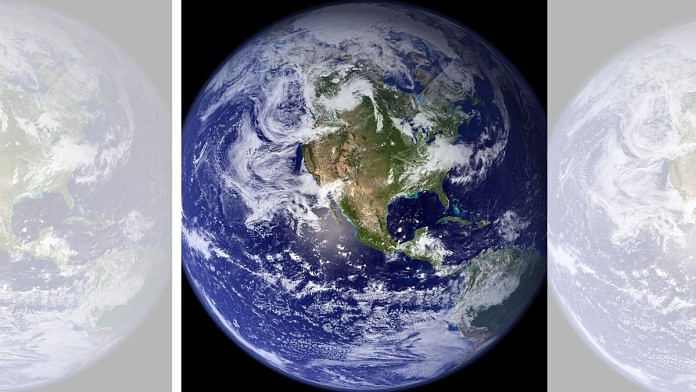New Delhi: A new study by US scientists has suggested a fascinating origin for two ‘continent-sized’ mysterious rock structures deep inside Earth’s mantle.
These structures, called large low-velocity provinces (LLVPs), are slightly denser than the surrounding mantle and span thousands of kilometres. They also slow down seismic waves that pass through them, indicating a different composition.
The study, published in the journal Nature on 1 November, used computer simulations to show that these structures could be the remnants of a giant planetoid named Theia, which collided with Earth 4.5 billion years ago.
This collision is widely believed to have created the Moon, as some of the debris from Theia was thrown into orbit and later integrated into the lower portion of Earth’s mantle and eventually coalesced to form the Moon.
The simulations also suggest that the collision partially melted Earth’s mantle, creating a two-layer structure. The upper layer was molten and mixed with some of Theia’s material, while the lower layer was solid and accumulated most of Theia’s remains into the two peculiar blobs or LLVPs.
This theory could explain both the formation of the Moon and the anomalies in Earth’s mantle. Read more.
Also Read: 2022 ‘Marsquake’ mystery solved — here’s why planet shook for 6 hours, and it wasn’t a meteorite
Hidden link between the heart, brain and fainting
Syncope, or fainting, is a common but mysterious condition that affects about 40 percent of people at some point in their lives. It causes a temporary loss of consciousness, usually accompanied by symptoms such as eye-rolling and pupil dilation.
The exact cause of syncope has been elusive, but a new study published in the journal, Nature, on 1 November has uncovered a neural pathway that controls this phenomenon — offering critical insights into the underlying mechanisms of syncope.
The study, conducted by researchers from the University of California, San Diego, focuses on a group of neurons that connect the heart to the brainstem. These neurons sense the heart’s activity and send signals to the brain.
When these neurons were stimulated in mice, they quickly fainted and stopped moving, mimicking human syncopes, such as rapid pupil dilation and eye-rolling.
This finding challenges the conventional view that syncope is mainly caused by low blood flow to the brain. It reveals a previously overlooked neural link between the heart and brain, offering a more comprehensive picture of the mechanisms behind fainting.
The study also identifies a specific brain region, called the periventricular zone (PVZ), that plays a crucial role in regulating fainting and recovery. When the PVZ was inhibited, mice fainted for longer periods, while activating the PVZ helped them wake up and resume movement.
This research sheds light on the neural basis of syncope, enhancing our understanding of a common yet poorly explained condition. Read more.
Also Read: Interlocking logs from 476,000 years ago found in Zamibia 100,000 yrs older than oldest human fossil
NASA’s Lucy encounter reveals a surprise
NASA’s Lucy spacecraft achieved a remarkable feat on 1 November by flying past asteroid Dinkinesh — the first of 10 asteroids it will explore over the next 12 years.
But the encounter was even more surprising when it revealed that Dinkinesh, which in the Amharic language means “marvellous”, is actually a pair of asteroids orbiting each other.
NASA announced in a press release issued Friday that Dinkinesh’s brightness variations had hinted at its binary nature, but the flyby confirmed it. It also revealed that the larger asteroid is about 804 metres wide, while the smaller one is about 240 metres.
Launched in October 2021, Lucy is a NASA mission that aims to study asteroids near and far. While this encounter is a key in-flight test of the spacecraft, its main objective is to visit the Trojan asteroids, which circle the Sun at the same orbital distance as Jupiter.
These distant Trojans are like fossils of our solar system’s history, and scientists are eager to learn more about them. Lucy’s mission is to collect valuable data that will help us understand how our cosmic neighbourhood formed and evolved. Read more.
Light can also evaporate water
A new study by researchers from the Massachusetts Institute of Technology has revealed a surprising phenomenon — light can make water evaporate faster than heat, under certain conditions.
The study, published in the Proceedings of the National Academy of Sciences (PNAS) Journal on 30 October, challenges the conventional understanding of evaporation and suggests that this effect may occur in other situations as well.
The researchers found that solar evaporation rates sometimes exceeded the theoretical predictions, meaning that water was evaporating faster than the heat it received could explain.
They called this the ‘photomolecular effect’, a phenomenon where light, especially at the water-air interface, causes water molecules to escape from the surface leading to heightened evaporation. The researchers observed this effect when water was trapped within a hydrogel material, a gel-like substance that can hold water.
They discovered that light photons could knock off clusters of water molecules from the water’s surface, making it evaporate more efficiently. This effect only happened at the boundary layer between water and air, such as the surface of the hydrogel, the sea, or the droplets in clouds or fog.
This discovery has important implications for various fields. It could affect the formation and evolution of clouds and fog, which could improve the accuracy of climate models.
It could also revolutionise some industrial processes, such as solar-powered desalination, by offering alternatives to the traditional step of converting sunlight into heat. Read more.
(Edited by Richa Mishra)
Also Read: 40% amphibians facing extinction. Leading reason isn’t disease or habitat loss anymore



